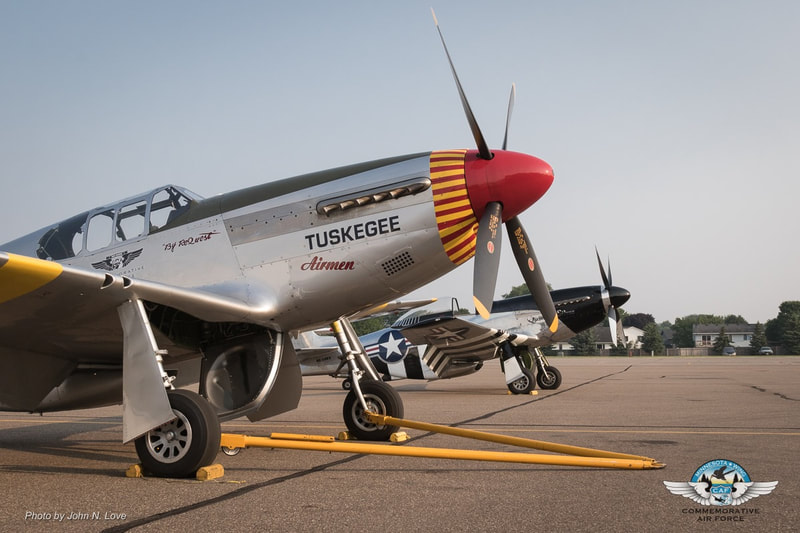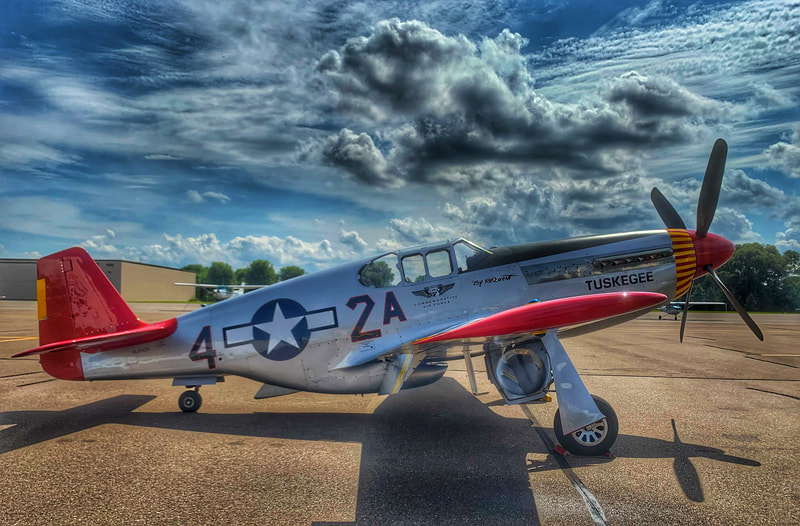|
Special visitors to the museum this month were two P-51 Mustangs. The sleek P-51 Mustang is perhaps the best all-around fighter of World War II. In 1939, British officials approached North American Aviation in desperate need of additional aircraft for the war in Europe. Just 117 days after the order was placed, the first P-51 was rolled out of the factory.
Equipped with an American-built copy of the Rolls-Royce Merlin engine, the P-51 quickly became one of the best-known and most feared fighters in the world—able to escort heavy bombers deep into enemy territory. A total of 15,567 Mustangs of all types were built for the Army and foreign nations. In combat, they destroyed nearly 6,000 enemy aircraft, making the Mustang the deadliest Allied fighter of World War II. The CAF Red Tail Squadron’s P-51C Mustang, named Tuskegee Airmen, is an authentic and fully restored operational fighter from the WWII era. The Tuskegee Airmen were the first Black military aviators in the U.S. Army Air Corps (AAC), a precursor of the U.S. Air Force. Trained at the Tuskegee Army Air Field in Alabama, they flew more than 15,000 individual sorties in Europe and North Africa during World War II. Their impressive performance earned them more than 150 Distinguished Flying Crosses, and helped encourage the eventual integration of the U.S. armed forces. This awe-inspiring aircraft sparks conversations to educate young and old alike about the often-overlooked history of the Tuskegee Airmen that flew this same model as their signature aircraft in WWII. The Mission of the P-51 Quick Silver is to honor and pay tribute to the veterans that have sacrificed their lives for the freedom and security of others. Quick Silver is a celebration of our nation’s armed forces. Every aspect of the paint represents those who have served, and those who gave the ultimate sacrifice. The black cape covering the front of the aircraft represents the veil of protection that our armed forces give us. That veil is one of the reasons why we have what we have today, freedom. As the cape extends to the back of the canopy, it spreads out and divides into feathers, symbolizing the eagle that has flown with every aviator since the birth of aviation in 1903. The black paint has tiny sparkling stars in it, each sparkle represents an American Veteran that served our great country; the unsung stars in our lives. These veterans are the glimmering star in a mother’s eye, a wife or husband’s heart, a son or daughter’s hope for the future. The silver ring behind the spinner represents the shinning halo of the guardian angel who guides service personnel, having given the ultimate sacrifice, to their final resting place. The black and white stripes on the wings are there, as they were on all allied aircraft on D-day. The stars and bars, proudly displayed, represent the armed forces symbol that all United States fighter planes carry. It carries the post war version because “Quick Silver” was never a part of a unit till after World War II. All of the bare metal of this P-51 Mustang is polished. Look closely into the metal, you can see for whom our veterans fought.
2 Comments
Mike
7/25/2021 09:13:56 pm
Are the P 51 Mustang still available to be viewed there please let me know thank you.
Reply
Amy
7/26/2021 02:56:27 am
They have gone on to other shows. Thanks!
Reply
Leave a Reply. |
AuthorWelcome to the CAF MN Wing Blog. You will find information on projects we are working on, upcoming events, and more. Archives
April 2024
Categories
All
|


 RSS Feed
RSS Feed